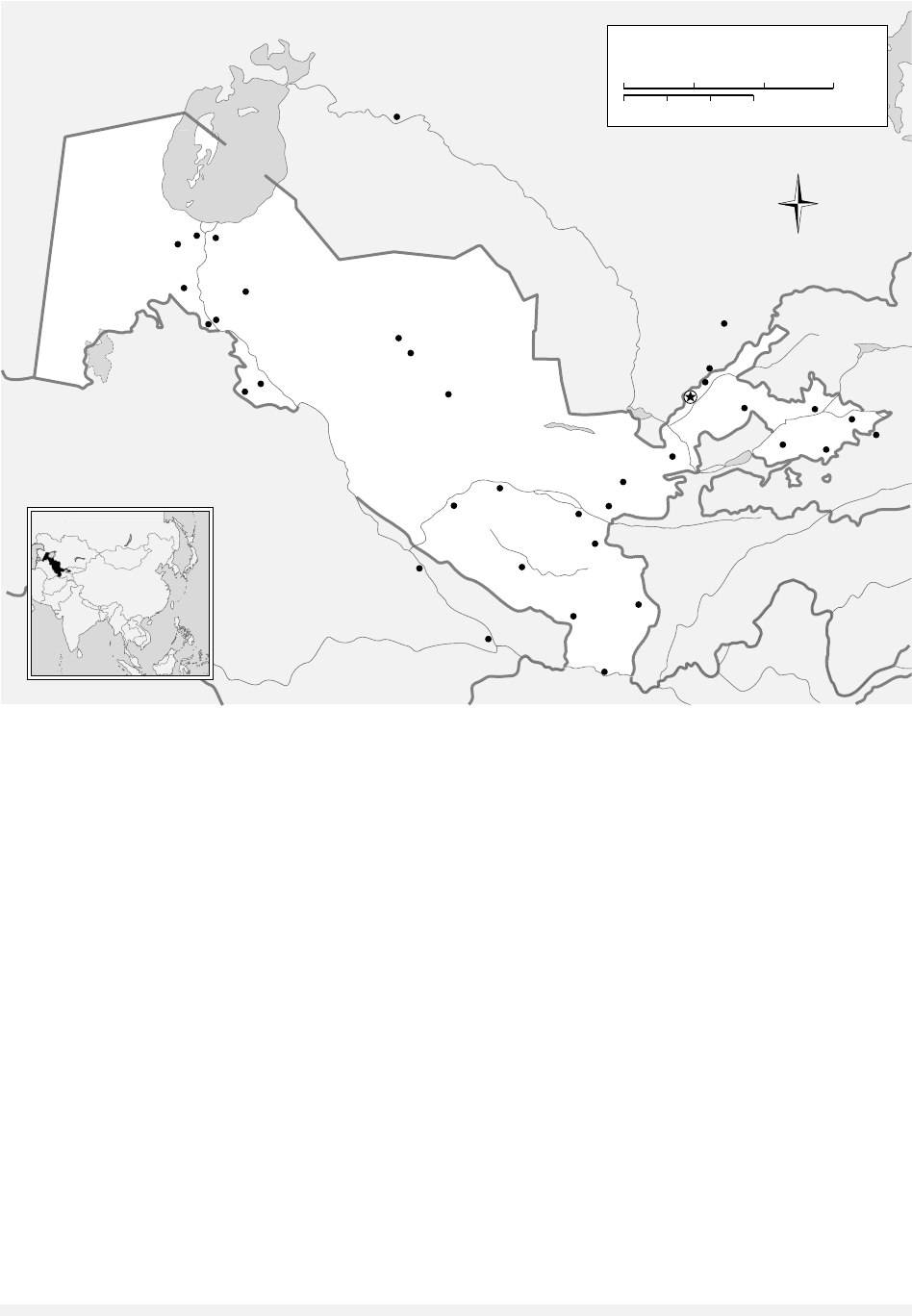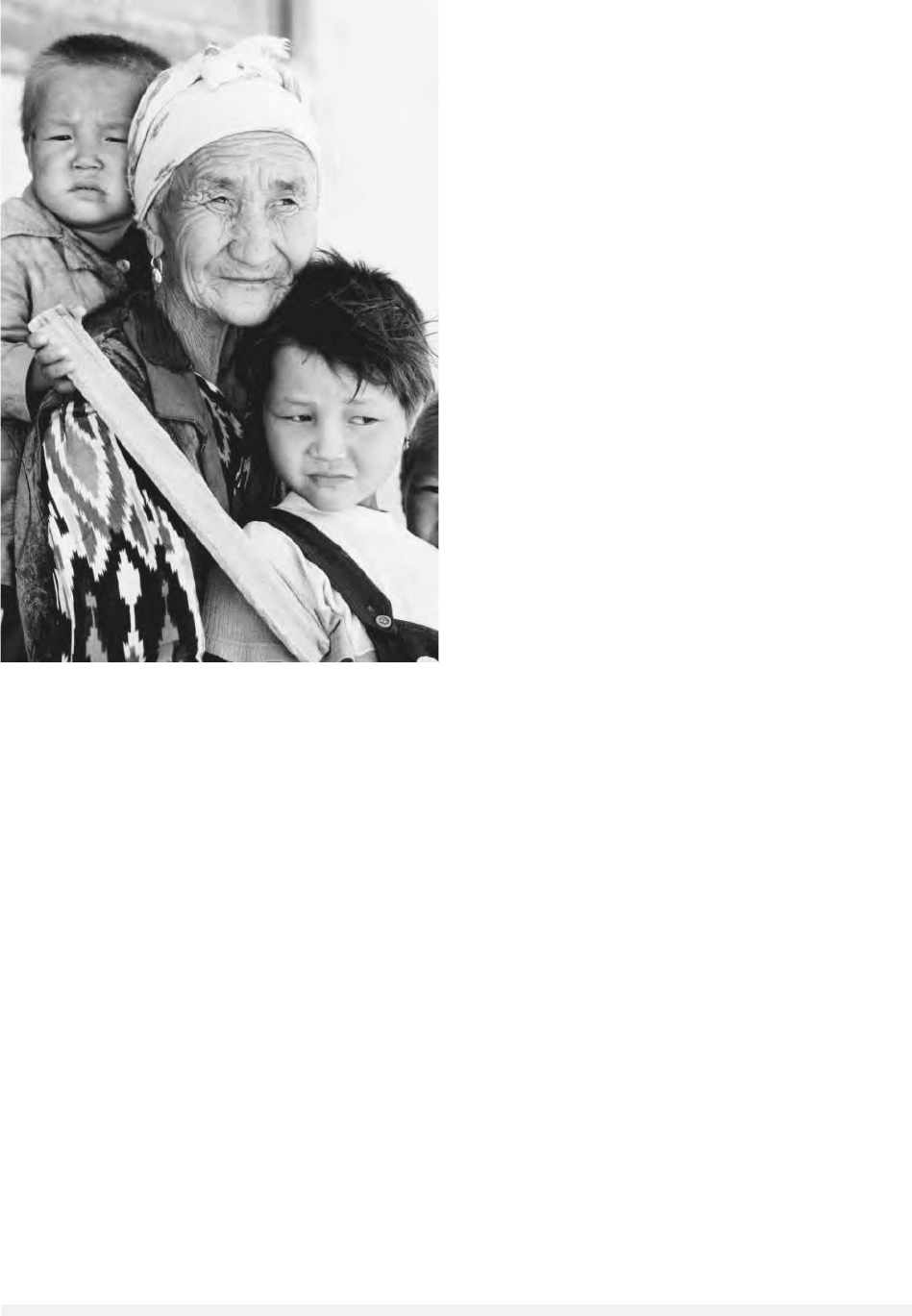Encyclopedia of Russian History
Подождите немного. Документ загружается.


legitimate authority and the territorial integrity of
existing states in Europe and the Near East.
Nicholas was concerned about the domino effect of
successful revolutions against dynastic states. Un-
able to contain the rebellion of Muhammad Ali in
Egypt, the Ottoman state was threatened by his ad-
vance across Syria and Anatolia in 1832. In re-
sponse, on February 20, 1833, a Russian naval
squadron arrived in Constantinople, followed by
Russian ground forces, with the intent of protect-
ing the Sultan’s capital from the rebels.
The treaty created an eight-year alliance be-
tween Russia and the Ottomans and provided for
Russian aid in the event of an attack against the
Sultan. It reconfirmed the 1829 Treaty of Adri-
anople, which recognized Russian gains in the
Balkans and the Caucasus as well as providing free
access through the Straits for Russian merchant
ships. A secret addendum to the treaty also required
the Ottoman Empire to close the Straits to foreign
warships. Nicholas and his foreign minister, Count
Karl Nesselrode, preferred to see the Straits remain
in Ottoman hands rather than risk the disintegra-
tion of the Ottoman state whereby another Euro-
pean power such as France or Britain might take
control of this strategic waterway.
The treaty appealed to Nicholas’s sense of Rus-
sia as the premier defender of legitimism in post-
Napoleonic Europe. It also confirmed Russian
supremacy in the Black Sea basin and guaranteed
the free passage of Russian commercial vessels into
the Mediterranean, an important point given the
growing importance of Russia’s export trade from
ports such as Odessa.
The treaty was superseded by the Straits Con-
vention of July 13, 1841, when a five-power con-
sortium guaranteed the permanent closure of the
Straits to all warships. Hopes for a more perma-
nent Russo-Ottoman alliance were dashed, how-
ever, when the alliance was not renewed, helping
to lay the groundwork for the Crimean War.
See also: NICHOLAS I; TURKEY, RELATIONS WITH
BIBLIOGRAPHY
Fuller, William C., Jr. (1992). Strategy and Power in Rus-
sia, 1600–1914. New York: Free Press.
Riasanovsky, Nicholas V. (1984). A History of Russia. Ox-
ford: Oxford University Press.
N
IKOLAS
G
VOSDEV
USHAKOV, SIMON FYODOROVICH
(1626-1686), renowned Russian artist.
Simon Ushakov has been called the last great
master of Russian painting. At the age of twenty-
two (1648) he was appointed court painter and en-
trusted with the state icon painting studios in the
Armory Palace. He not only painted icons, but
made signs, did jewelers’ work, embroidered, and
even designed coins. In addition, he became an ex-
pert on fortifications, mapmaking, and engraving.
As the head of Tsar Alexei Mikhailovich Romanov’s
(r. 1645–1676) workshop, he painted several por-
traits of the tsar and the royal family. The tsar had
a profound interest in western European culture
and hired foreign actors and musicians to perform
at court. Western architecture also held the ruler’s
interest, so it is understandable why Ushakov’s
westernized icon style became the most acceptable
form in court circles.
Ushakov became involved in theoretical art dis-
cussions. He wrote “Words to the Lovers of Icons,”
which advanced his views on painting with an em-
phasis on naturalism. The idealization of the saints’
faces in his icons led others to refer to him as a
Slavic Raphael. The colors Ushakov favored in-
cluded rose pink, olive green, pale lilac, occasion-
ally sky blue, and shades of tans and brown.
Western influence can be seen not only in the saints’
lifelike faces but also in the use of classical archi-
tecture, as well as landscapes and scenery borrowed
from German paintings and etchings.
One of themes that Ushakov painted frequently
was the Mandilion (Spas Nerukotvorny or “The Sav-
ior Painted without Use of Human Hands”). Even
though he continued to use egg tempera, rather
than the new oil painting broadly adopted in the
West, he nevertheless abandoned the traditional
two-dimensional, bright-colored style that empha-
sized intense inner spirituality. Instead he prettified
the faces, creating images that in many ways
resembled the Madonnas painted by the Italian Re-
naissance master, Raphael. A mixed style charac-
terizes Ushakov’s work at this time. His style
became the official Orthodox style, copied by many
contemporary Russian icon painters.
Ushakov’s most famous and revolutionary icon
is the Vladimir Mother of God and the Planting and
Spreading of the Tree of the Russian State, painted in
1668. This is a blatantly political icon. A huge rose-
bush symbolizes the Muscovite state; within it is a
USHAKOV, SIMON FYODOROVICH
1624
ENCYCLOPEDIA OF RUSSIAN HISTORY

representation of the most venerated icon in Rus-
sia, the Vladimir Mother of God. Christ appears at
the very top, directing his angels to spread his
sheltering cloak. The rosebush springs out of the
Kremlin; Metropolitan Peter and Grand Duke Ivan
Danilovic water it. The tsarist family appears near
the planting, while within the spreading branches
are medallions depicting Russia’s secular and eccle-
siastical princes and her most famous saints.
With his mixed technique Ushakov had a very
strong impact on the development of icon painting
in Russia. Among his pupils who became famous
icon painters were Georgy Zinoviev, Ivan Maxi-
mov, and Mikhail Malyutin. After Ushakov’s time,
the traditional style that had preceded him sur-
vived, but progressive artists adapted his more
Western style up to the twentieth century.
See also: ARCHITECTURE; ICONS
BIBLIOGRAPHY
Onasch, Konrad. (1963). Icons. London: Faber and Faber.
Hamilton, George H. (1990). The Art and Architecture of
Russia. London: Penguin Group.
A. D
EAN
M
C
K
ENZIE
USSR See UNION OF SOVIET SOCIALIST REPUBLICS.
USTINOV, DMITRY FEDOROVICH
(1908-1984), marshal of the Soviet Union; Soviet
minister of defense; member of the Politburo, leader
of wartime production in the Soviet Union during
World War II; Hero of the Soviet Union.
Dmitry Ustinov was born in Samara before the
Bolshevik Revolution. In 1922, at the age of four-
teen, he volunteered for service in the Red Army.
In 1923 he was demobilized and attended a poly-
technical institute in Makarev and then began to
work in defense industry. A member of the emerg-
ing Soviet technical intelligentsia, he joined the
Communist Party in 1927, graduated from the
Military Mechanical Institute in 1934, and joined
the Scientific-Technical Institute for Naval Artillery
the same year. In 1937 he began work as a design
engineer at the Bolshevik defense industry complex
in Leningrad and in 1938 became the plant direc-
tor. With the German invasion of the Soviet Union
he was appointed people’s commissar of arma-
ments. In this capacity he played a leading role in
organizing production of Soviet defense industries
and was a leading member of Stalin’s war cabinet,
the State Committee of Defense. In 1944 he was
promoted to the military rank of colonel-general.
In the postwar period Ustinov continued his lead-
ership of Soviet defense industries down to 1957.
He held the posts of deputy chairman of the Coun-
cil Ministers and first deputy chairman of the
Council of Ministers from 1957 to 1965. From
1965 to 1976 he served in the Secretariat of the
Central Committee of the Communist Party, where
he directed the activities of research institutions, de-
sign bureaus, and enterprises. Ustinov was a can-
didate member of the Politburo in 1976 and a Full
Member from 1976 until his death in 1984. In April
1976 he was appointed minister of defense. Dur-
ing his tenure as minister, the Soviet Union began
its ill-fated intervention in Afghanistan.
See also: BREZHNEV, LEONID ILICH; MILITARY, SOVIET AND
POST-SOVIET; STATE DEFENSE COMMITTEE; WAR
ECONOMY
BIBLIOGRAPHY
Barber, John, and Harrison, Mark. (1999). The Soviet De-
fence-Industry Complex from Stalin to Khrushchev.
London: Palgrave Macmillan.
Gelman, Harry. (1984). The Brezhnev Politburo and the De-
cline of Détente. Ithaca, NY: Cornell University Press.
Spielmann, Karl F. (1978). Analyzing Soviet Strategic Arms
Decisions. Boulder, CO: Westview Press.
Ustinov, Dmitry. (1983). Serving the Country and the Com-
munist Cause. Oxford: Pergamon Press.
J
ACOB
W. K
IPP
UVAROV, SERGEI SEMENOVICH
(1786-1855), minister of education (1833–1849)
and Academy of Sciences president (1818–1855).
Sergei Uvarov was the longest-tenured and
most influential minister of education and Academy
of Sciences president in Imperial Russian history.
From 1810 to 1821, he also served as superinten-
dent of the St. Petersburg Educational District. In-
deed, Uvarov spent his entire life involved with the
arts and sciences. He published poetry in his teens;
actively participated in the literary quarrels of his
day; authored two dozen essays on literary and
UVAROV, SERGEI SEMENOVICH
1625
ENCYCLOPEDIA OF RUSSIAN HISTORY

historical topics; and in retirement, completed the
work for a doctorate in classical studies.
As a statesman, from the 1810s Uvarov acted
upon a certainty that Russia was in its youth and
developing into a West European-style nation. He
was determined, however, that the process of mat-
uration would occur without European-style rev-
olutions and that the educational system would
provide the map for following this special path. He
gave his system a slogan, “Orthodoxy, Autocracy,
Nationality” (Pravoslavie, Samoderzhavie, Narodnost).
This tripartite formula offered a simple, accessible,
patriotic affirmation of native values and an anti-
dote against revolutionary ideas. Devotion to the
Russian Orthodox Church would offset modern
materialism. Autocracy would provide stability
with patriarchal but progressive tsarist leadership.
The concept of nationality promoted an indigenous
attempt to answer the problems of modern devel-
opment, a quest, though, that was to be defined
and guided by the state, not the narod, or people.
Uvarov believed that raising the Russian edu-
cational system to a level of excellence was the sine
qua non for the empire’s progress toward maturity.
He transformed the Academy of Sciences from a
shambles into a world-renowned center of learn-
ing. Uvarov created two first-rate universities, St.
Petersburg (1819) and St. Vladimir’s (1833) and
brought the others to a golden age. He reformed
the gymnasia by introducing the classical curricu-
lum and the study of Russian grammar, history,
and literature. He patronized a new emphasis on
technology and science in education, and he over-
saw the birth of Oriental, Slavic, classical, and
philological studies. For these accomplishments, he
received the title of count in 1846.
While Uvarov’s accomplishments are notable,
his reputation suffered during his lifetime because
of his personal traits, such as greed and arrogance,
and his autocratic handling of his ministry, espe-
cially in the area of censorship. Historians have
tended to dismiss Uvarov as a liberal during the
reign of Alexander I and a reactionary during the
time of Nicholas, ascribing this to his groveling be-
fore the powers-that-be. This interpretation is gain-
said by the fact that he resigned twice, in 1821 and
1849, when tsarist policy turned reactionary and
threatened the aim of educational excellence to
which he had dedicated his life.
See also: EDUCATION; UNIVERSITIES
BIBLIOGRAPHY
Riasanovsky, Nicholas V. (1959). Nicholas I and Official
Nationality in Russia, 1825–1855. Berkeley: Univer-
sity of California Press.
Whittaker, Cynthia H. (1984). The Origins of Modern
Russian Education: An Intellectual Biography of Count
Sergei Uvarov, 1786–1855. DeKalb: Northern Illinois
University Press.
C
YNTHIA
H
YLA
W
HITTAKER
UZBEKISTAN AND UZBEKS
The Uzbeks are a people who settled in the oases
regions of Central Asia more than five hundred
years ago. Early references to Uzbeks suggest that
they were nomadic peoples who lived in the steppes
of what is today Kazakhstan and southern Siberia,
although there is conflicting evidence as to their
origin. Gradually moving southward, they became
a political force in the fifteenth and sixteenth cen-
turies, and were associated with the region be-
tween the great rivers of the Amu Darya and
the Syr Darya. During the early twenty-first cen-
tury, ethnic Uzbeks can be found in Kazakhstan,
the Kyrgyz Republic, Tajikistan, Turkmenistan,
Afghanistan, as well as smaller communities in
Turkey and China. The majority of Uzbeks live in
the country of Uzbekistan, which is located among
the states noted above in the region between the
Aral Sea to the west and the Tien Shan and Pamir
mountains to the east. Uzbekistan has an area of
447,400 square kilometers (172,700 square miles)
and a population estimated at 25,563,441 people.
Approximately 20,450,000 of these citizens are
ethnic Uzbeks (80%). Significant minorities in
Uzbekistan include Russians (5.5%), Tajiks (5.0%),
Kazakhs (3.0%), Karakalpaks (2.5%), and Tatars
(1.5%). The capital city of Uzbekistan is Tashkent,
which has an estimated population of 2.6 million,
although unofficial counts place the number at
nearly 3.5 million people. Other significant cities
include Samarkand, Bukhara, Andijon, Naman-
gan, and Fergana.
The majority of Uzbeks are Sunni Muslims of
the Hanafi School. Given that several key cities of
Uzbekistan, specifically Bukhara and Samarkand,
were centers of learning in the Islamic world for
centuries, the traditions of that faith are strong in
the country. Even during the Soviet period, when
there were stringent restrictions on Islamic prac-
tices, the religion was practiced in the country.
UZBEKISTAN AND UZBEKS
1626
ENCYCLOPEDIA OF RUSSIAN HISTORY

Other religions coexist in Uzbekistan and reflect the
ethnic minorities, such as the Russians.
Linguistically, Uzbek is a Turkic language and,
to varying degrees, is mutually intelligible with the
other Turkic languages in the region such as
Kazakh, Kyrgyz, Karakalpak, and Turkmen. Orig-
inally Uzbek was written in the Arabic script. Dur-
ing the Soviet period, this was switched to the Latin
script in the 1920s and later to the Cyrillic script
in 1940. In the post-Soviet period, the Uzbek gov-
ernment decided to return to a Latin script, using
Turkish orthography.
There are significant discussions as to the ori-
gins of the Uzbeks and when they arrived in the
region they occupy today. Indeed, it is accepted that
Tamerlane (Timur the Lame) was an Uzbek and the
first Uzbek unifier of Central Asia. Interestingly,
the Timurid dynasty under Babur (Tamerlane’s
grandson) was defeated by Shaybani Khan, an
Uzbek leader, at the beginning of the sixteenth cen-
tury. Many international historians consider this
event to be the true introduction of Uzbeks to the
region and the first Uzbek state in Central Asia. For
the next four centuries, three main Uzbek states
developed in Central Asia—the Emirate of Bukhara
and the Khanates of Khiva and Kokand. Identity at
this time focused on which city one belonged to,
or more importantly, to one’s faith—Islam. At the
time, these states were not really identified with the
ethnic group of Uzbeks, which was seen as a pop-
ulation more divided by and distinguished among
tribal sub-groupings. Up through the twentieth
century, these states more often used Persian as the
court languages, while Uzbek was used among the
common people.
UZBEKISTAN AND UZBEKS
1627
ENCYCLOPEDIA OF RUSSIAN HISTORY
T
u
r
a
n
L
o
w
l
a
n
d
P
e
s
k
i
S
a
m
m
u
K
l
y
z
y
K
Ustyurt
Peski
m
u
g
a
r
a
G
Aral
Sea
Sarykamyshskoye
Ozero
A
m
u
D
a
r
'
y
a
S
y
r
D
a
r
'
y
a
Z
e
r
a
v
s
h
a
n
Q
a
s
h
q
a
d
a
r
y
o
C
h
i
r
c
h
i
q
S
y
r
D
a
r
'
y
a
Tashkent
Shymkent
Samarqand
(Samarkand)
Chärjew
(Chardzhou)
Termez
Muynak
Urga
Kungrad
Nukus
Takhtakupyr
Khodzheyli
Urganch
Uchkuduk
Kulkuduk
Zarafshan
Leninsk
Akkala
Navoi
Derbent
Bukhoro
(Bukhara)
Qarshi
Kerki
Denau
Shakhrisabz
Jizzakh
Guliston
Namangan
Angren
Chirchik
Iskandar
Andijon
Osh
Farghona
Kokand
Bulunghur
Khiva
TURKMENISTAN
TAJIKISTAN
KAZAKHSTAN
KYRGYZSTAN
W
S
N
E
Uzbekistan
UZBEKISTAN
225 Miles
0
0
225 Kilometers
75 150
75 150
Uzbekistan, 1992. © M
ARYLAND
C
ARTOGRAPHICS
. R
EPRINTED WITH PERMISSION

During the 1850s and 1860s the Russian em-
pire began to aggressively seek control over the var-
ious regions of Central Asia. This has often been
couched in terms of the Great Game with the British
Empire, which was a contest for dominance in the
region. In 1865 Russian military forces systemat-
ically took over cities in the Kokand Khanate and
Bukharan Emirate, beginning with the sacking of
Tashkent in that year. By 1876 the Khanate of
Kokand was dissolved and incorporated into the
Governor-Generalship of Turkestan. The Khanate
of Khiva in the west and the Bukharan Emirate
were reduced to the status of protectorates. Dur-
ing the next forty years, this region was part of
the Russian empire. In general, the Russian over-
lords sought to obtain taxes and raw materials
from the region and left the indigenous populations
to their own social and cultural traditions.
The Russian Revolution of 1917 and the Civil
War resulted in radical changes for Central Asia.
Eventually, the region was consolidated under Bol-
shevik rule and new political structures were cre-
ated. The first entity called Uzbekistan appeared in
1924 with the National Delimitation in the Soviet
Union. The Uzbek Soviet Socialist Republic actually
included the Tajik Autonomous Republic. This east-
ernmost portion was granted full Union Republic
status in 1929. With modest border adjustments
over the ensuing decades, the Uzbek S.S.R. was con-
sidered to be the homeland for the Uzbeks living in
the Soviet Union. When the Soviet Union collapsed
in 1991, the Uzbek S.S.R. declared its independence
and has henceforth been called the Republic of
Uzbekistan.
For much of the Soviet period, Uzbekistan was
the primary cotton-producing region of the Soviet
Union, with annual quotas exceeding four and five
million metric tons by the 1980s. In addition,
Uzbekistan was a major supplier of gold, strategic
minerals, gas, and agricultural products. In the
post-Soviet period, these commodities remain the
foundation for Uzbekistan’s economy. Uzbekistan
is one of the few states of the former Soviet Union
that did not experience a radical drop in production
and income during the 1990s, largely because of
its reliance on exporting these goods. However, the
country’s economy has not rebounded quickly be-
cause of difficulties in the currency market and the
obstacles faced by foreign investors. Moreover, the
steady increase in population has resulted in a
growing labor force that continues to experience a
high unemployment rate.
Politically, there was also continuity at the time
of independence. In 1991 the president of the Uzbek
S.S.R., Islam Karimov, was elected President of
Uzbekistan. In 1999 and 2000 the militant Islamic
Movement for Uzbekistan (IMU) unsuccessfully at-
tempted to destabilize the country. The government
since considers Islamic extremism to be a major se-
curity concern for the country, whether it is in the
guise of the IMU or the broader, internationally-
based group Hezb-ut Tahrir.
Throughout the 1990s and the early twenty-
first century, Uzbekistan has tried to assert itself
as a leading state in Central Asia. Of great impor-
tance was the desire to reduce the influence of Rus-
sia and remove the notion of an elder brother in the
region. Consequently, Uzbekistan has diplomatic
and economic ties with a number of important
powers, such as China, India, the United States, the
European Union, Turkey, and Iran. Since the events
of September 11, 2001, and the subsequent U.S.
led actions in Afghanistan, Uzbekistan has been
UZBEKISTAN AND UZBEKS
1628
ENCYCLOPEDIA OF RUSSIAN HISTORY
An elderly woman and children in Muyank, Uzbekistan, in
1989. © D
AVID
T
URNLEY
/CORBIS

more active in NATO Partnership for Peace programs
and bilateral security relations with the United
States. Ultimately, Uzbekistan would prefer to see
a greater emphasis on a Central Asian regional se-
curity arrangement, with itself as the key member.
See also: CENTRAL ASIA; ISLAM; NATIONALITIES POLICIES,
SOVIET; NATIONALITIES POLICIES, TSARIST
BIBLIOGRAPHY
Allworth, Edward. (1990). The Modern Uzbeks: From The
Fourteenth Century To The Present: A Cultural History.
Stanford, CA: Hoover University Press.
Babushkin, L. N., ed. (1973). Soviet Uzbekistan. Moscow:
Progress Publishers.
Bohr, Annette. (1998). Uzbekistan: Politics and Foreign
Policy. London: RIIA.
Gleason, Gregory. (1997). The Central Asian States: Dis-
covering Independence. Boulder, CO: Westview Press.
Kangas, Roger. (2002). Uzbekistan in the Twentieth Cen-
tury: Political Development and the Evolution of Power.
New York: St. Martin’s Press.
Karimov, Islam. (1997). Uzbekistan on the Threshold of the
Twenty-First Century. Surrey, UK: Curzon Press.
Levitin, Leonid, with Carlisle, Donald S. (1995). Islam Ka-
rimov: President of the New Uzbekistan. Vienna: Agrotec.
MacLeod, Calum, and Mayhew, Bradley. (1999). Uzbek-
istan: The Golden Road to Samarkand. London: Odyssey.
Melvin, Neil. (2000). Uzbekistan: Transition to Authori-
tarianism on the Silk Road. Amsterdam: Harwood
Academic Publishers.
R
OGER
K
ANGAS
UZBEKISTAN AND UZBEKS
1629
ENCYCLOPEDIA OF RUSSIAN HISTORY

VALUE SUBTRACTION
Value subtraction, or negative value added, occurs
when resources and other inputs used in the pro-
duction process generate output with a lower value
than that of the original resources and inputs. The
management of Soviet state-owned enterprises, fo-
cusing on fulfilling plan targets in order to receive
a bonus, tended to fulfill the main plan target,
quantity of output, with little regard for cost or
efficiency considerations. At the same time, enter-
prises faced centrally determined prices for both
the input used and the output produced. Soviet
centrally determined prices were not based upon
supply and demand conditions in either the do-
mestic or global market, nor were they adjusted in
response to obvious surplus or shortage condi-
tions. Consequently, neither the prices nor the cor-
responding profits or losses generated in the
planning process provided meaningful information
to Soviet firms in terms of whether to expand or
contract their operations. The primary obligation
of each firm was to fulfill annual output plan
targets.
Value subtraction characterized the operation
and performance of Soviet firms when their inputs
and output were valued at world market prices.
World market prices were more accurate reflections
of the economic cost of producing an item than So-
viet centrally determined prices, because they in-
corporated marginal rather than average costs of
production, and because they adjusted to surplus
and shortage conditions generated by ever-changing
actions of buyers and sellers. Typically, Soviet
prices were well below world market prices for the
majority of resources and other inputs used in the
production process. Consequently, when world
market prices were applied by Western researchers
and analysts to the actual resources and inputs
used in the Soviet production process, the newly
calculated costs of production were much higher.
These higher costs were not offset by applying
world market prices to the produced output, how-
ever, because the technological level of Soviet en-
terprises and abject quality assessments kept Soviet
output valuations low in comparison to world
standards. The existence of value subtraction, or
negative value added, was confirmed by Soviet
economists and analysts when glasnost and pere-
stroika in the late 1980s allowed more frank and
detailed discussions of actual conditions in the So-
viet economy.
V
1631

See also: HARD BUDGET CONSTRAINTS; RATCHET EFFECT;
VIRTUAL ECONOMY
S
USAN
J. L
INZ
VARANGIAN See VIKINGS.
VARENNIKOV, VALENTIN IVANOVICH
(b.1923), commander-in-chief of the Soviet Ground
Forces; deputy minister of defense; General of the
Army; Hero of the Soviet Union; member of the
State Duma.
Valentin Krasnodar was born on December 13,
1923, in Krasnodar in the Kuban region of South
Russia. He joined the Red Army in 1941 as an of-
ficer cadet and was commissioned in 1942. He took
part in the defense of Stalingrad as an artillery of-
ficer and served in that capacity through the war
to the assault on Berlin. Varennikov was a stand-
bearer at the Victory Parade in Red Square in 1945.
After the war he commanded artillery and infantry
units. In 1954 he graduated from the Frunze Mil-
itary Academy.
Varennikov advanced in the army leadership
and graduated from the Voroshilov Military Acad-
emy of the General Staff in 1967. During the late
1960s and early 1970s he commanded an army
and served as deputy commander of the Soviet
Group of Forces in Germany and as commander of
the Carpathian Military District. In 1979 he was
head of the Operations Directorate of the General
Staff, which planned the military intervention in
Afghanistan. In 1984 he assumed the post of
deputy chief of the Soviet General Staff with re-
sponsibility for direct oversight of operations in
Afghanistan; he later oversaw the withdrawal of
Soviet forces.
In January 1989 Varennikov was made com-
mandor of Soviet Ground Forces. In August 1991
he was an active participant in the conspiracy to
remove Mikhail Gorbachev and prevent the procla-
mation of a new union treaty. During the at-
tempted coup Varennikov was in Kiev. Arrested and
jailed when the coup collapsed, Varennikov refused
to accept an amnesty when it was offered in March
1994. Later that year, the Military Collegium of
the Supreme Court ruled that he was not guilty of
treason. In December 1995 he ran for election to
the State Duma as a candidate from the Commu-
nist Party and won. He won re-election in 2000
and serves as chairman of the parliamentary Com-
mittee on Veterans’ Affairs.
See also: AUGUST 1991 PUTSCH; MILITARY, SOVIET AND
POST-SOVIET
BIBLIOGRAPHY
Gorbachev, Mikhail. (1991). The August Coup: The Truth
and the Lessons. New York: Harper Collins.
Kipp, Jacob W. (1989). “A Biographical Sketch on Gen-
eral of the Army Valentin Ivanovich Varennikov.”
Ft. Leavenworth, KS: Foreign Military Studies Office.
Odom, William E. (1998). The Collapse of the Soviet Mil-
itary. New Haven, CT: Yale University Press.
J
ACOB
W. K
IPP
VARGA, EUGENE SAMUILOVICH
(1879–1964), major figure in the Soviet econom-
ics establishment and expert on the world capital-
ist system who fell afoul of Stalinist dogma.
Eugene Varga was educated at the universities
of Paris, Berlin, and Budapest, receiving a doctoral
degree from the last in 1909. He joined the Hun-
garian Social Democratic Party in 1906 and was a
writer and editor on economic matters for its cen-
tral organ. When the communists came to power
in Hungary in 1919, he served as commissar of fi-
nance and then as chairman of the Supreme Coun-
cil of the National Economy. After the regime fell
he moved to the USSR.
Varga’s specialty was capitalist political econ-
omy and economic conditions in the capitalist
world, on which he was an influential and au-
thoritative spokesman during the interwar period.
He was elected a full member of the Soviet Acad-
emy of Sciences in 1939 and was director of its In-
stitute of World Economics and Politics until 1947,
when the institute was shut down because of the
views he expounded in Changes in the Capitalist
Economy as a Result of the Second World War. Varga
defended himself vigorously at a conference of
economists held to attack him, but was forced to
recant. In the post-Stalin period Varga was ulti-
mately restored to a position of honor, and in 1959
his eightieth birthday was celebrated as a notable
jubilee presided over by Academician Konstantin
Ostrovitianov, who had orchestrated the attack on
him in 1947. In 1963 he was awarded the Lenin
VARANGIAN
1632
ENCYCLOPEDIA OF RUSSIAN HISTORY

Prize for “scientific treatment of the problems of
modern capitalism.”
Despite his independence in analyzing economic
developments in the capitalist world, and his
courage in fighting Stalinist dogmatism, Varga was
a thoroughly orthodox Marxist, and a critic of the
ideas of Soviet econometricians and mathematical
economists.
See also: MARXISM
BIBLIOGRAPHY
Domar, Evsey. (1950). “The Varga Controversy.” Amer-
ican Economic Review 40:132–151.
R
OBERT
W. C
AMPBELL
VASILEVSKY, ALEXANDER MIKHAILOVICH
(1895–1977), Soviet military hero of World War II.
A member of the Communist Party from 1938,
Alexander Mikhailovich Vasilevsky was born in the
village of Novo-Pokrovka, now Ivanovo Oblast. He
graduated from military school in 1914. He served
as a junior officer in the tsarist army during World
War I. From 1918 to 1931 he commanded a com-
pany, then a battalion, then an infantry regiment
in the Red Army. From 1931 to 1936 Vasilevsky
held executive posts in combat training organs
within the People’s Commissariat of Defense and
Volga Military District. From 1937 to 1941 he
served on the General Staff, from 1941 to 1942 as
deputy chief, and from 1942 to 1945 (during
World War II or the Great Patriotic War) as Chief
of the General Staff of the Soviet Armed Forces and
concurrently, deputy people’s commissar of de-
fense of the USSR.
Upon instructions from the Supreme Com-
mand Headquarters, Vasilevsky helped to elaborate
many major strategic plans. In particular,
Vasilevsky was among the architects (and partici-
pants) of the 1943 Stalingrad offensive. He coordi-
nated actions of several fronts in the Battle of Kursk
and the Belorussian and Eastern-Prussian offensive
operations. Under Vasilevsky’s leadership, a strate-
gic operation aimed at routing the Japanese Kwan-
tung army was successfully carried out between
August and September of 1945.
Increasingly, after the German invasion of June
1941, officers with world-class military skills, who
either emerged unscathed by Stalin’s purges or
were retrieved from Stalin’s prisons and camps,
came to the fore. Vasilevsky was among these men.
Although Stalin was loath to trust anyone fully,
this innate distrust did not prevent him from tap-
ping the resources of his most talented military
strategists during World War II. In the first year
of the war, when the USSR was on the defensive,
Stalin often made unilateral decisions. However, by
the second year, he depended increasingly on his
subordinates. As Marshal Vasilevsky has recalled,
He came to have a different attitude toward
the General Staff apparatus and front com-
manders. He was forced to rely constantly on
the collective experience of the military. Before
deciding on an operational question, Stalin lis-
tened to advice and discussed it with his deputy
[Zhukov], with leading officers of the General
Staff, with the main directorates of the People’s
Commissariat of Defense, with the commanders
of the fronts, and also with the executives in
charge of defense production.
His most astute generals, Vasilevsky and Georgy
Zhukov included, learned how to nudge Stalin to-
ward a decision without talking back to him.
While serving as a member of the Central Com-
mittee of the Soviet Communist Party between
1952 and 1961, Vasilevsky also held the post of
first deputy minister of defense from 1953 to 1957.
Twice named Hero of the Soviet Union, he was also
twice awarded the military honor, the Order of Vic-
tory, and was presented with many other orders,
medals, and ceremonial weapons. He retired the fol-
lowing year and died fifteen years later.
See also: MILITARY, SOVIET AND POST-SOVIET; WORLD
WAR I; WORLD WAR II
BIBLIOGRAPHY
Beevor, Antony. (1999). Stalingrad: The Fateful Siege,
1942–1943. New York: Penguin Books.
Colton, Timothy. (1990). Soldiers and the Soviet State.
Princeton: Princeton University Press.
J
OHANNA
G
RANVILLE
VAVILOV, NIKOLAI IVANOVICH
(1887–1943), internationally famous biologist.
Nikolai Ivanovich Vavilov achieved international
fame as a plant scientist, geographer, and geneti-
cist before he was arrested and sentenced to death
VAVILOV, NIKOLAI IVANOVICH
1633
ENCYCLOPEDIA OF RUSSIAN HISTORY

on false charges of espionage in 1940. Born into
a wealthy merchant family in pre-revolutionary
Russia, Vavilov was renowned for his personal
charm, integrity, and international scientific pres-
tige. He graduated from the Moscow Agricultural
Institute in 1911, continued his studies of genetics
and horticulture in Europe the following year, and
in 1916 led an expedition to Iran and the Pamir
Mountains to search for ancestral forms of mod-
ern agricultural plant species. “The Law of Ho-
mologous Series in Hereditary Variation,” his first
major theoretical contribution, published in Russia
in 1920 and then in the Journal of Genetics, argued
that related species can be expected to vary genet-
ically in similar ways.
Vavilov spoke many languages and traveled ex-
tensively throughout the United States and Europe
to meet with colleagues and study scientific inno-
vations in agriculture. He is best known for The
Centers of Origin of Cultivated Plants (1926), in
which he established that the greatest genetic di-
versity of wild plant species would be found near
the origins of modern cultivated species. Until 1935
he organized expeditions to remote corners of the
world in order to collect, catalog, and preserve spec-
imens of plant biodiversity. In the Soviet Union
Vavilov was a powerful advocate and organizer of
scientific institutions, and he tirelessly promoted
research in genetics and plant breeding as a means
of improving Soviet agriculture. Vavilov was direc-
tor of the Institute of Applied Botany (1924–1929),
a member of the USSR Academy of Sciences, direc-
tor of the All-Union Institute of Plant Breeding
(1930–1940) and the Institute of Genetics
(1933–1940), president and vice-president of the
Lenin All-Union Academy of Agricultural Sciences
(1929–1938), and president of the All-Union Geo-
graphical Society (1931–1940).
Vavilov’s increasingly vocal and uncompro-
mising opposition to the falsification of genetic sci-
ence propagated by Trofim Lysenko and his
followers culminated in his arrest in 1940. His
death sentence was commuted to a twenty-year
prison term in 1942; he died of malnutrition in a
Saratov prison one year later. Vavilov is considered
a founding father in contemporary studies of plant
biodiversity. He left an important legacy as one of
the great Russian scientific and intellectual figures
of the early twentieth century.
BIBLIOGRAPHY
Graham, Loren R. (1993). Science in Russia and the Soviet
Union. New York: Cambridge University Press.
Krementsov, Nikolai. (1997). Stalinist Science. Princeton,
NJ: Princeton University Press.
Popovskii, Mark Aleksandrovich. (1984). The Vavilov Af-
fair. Hamdon, CT: Archon Books.
Y
VONNE
H
OWELL
VECHE
The veche was a popular assembly in medieval Russ-
ian towns from the tenth to the sixteenth centuries.
Veches became particularly active at the turn of the
twelfth century, before falling into decline except
in the towns of Novgorod, Pskov, and Viatka. At
times, the veche in Novgorod participated in se-
lecting or dismissing the posadniks (mayors) and
tysiatskiis (thousandmen). Originally, one tysiatskii
was head of the town militia but over time, sev-
eral were chosen and became judicial and civil of-
ficials. The veche also chose the archbishop, and the
heads of the major monasteries. It also tried cases,
ratified treaties, and addressed other public matters.
Meetings sometimes turned violent. In Imperial and
Soviet historiography, the veche was often used as
an example to demonstrate whether Russia had any
democratic tradition or had always been autocratic.
The veche remains an enigmatic phenomenon.
The word is rooted in the words ve and veshchati,
the latter meaning: to pontificate, play the oracle,
or to lay down the law. However, medieval chron-
iclers used the term not only to mean popular as-
semblies, but also to speak of crowds or mobs.
Primary sources are often silent as to the origin or
demise of the veche, the scope of its authority, its
specific membership, or the rules and procedures
governing its activities.
Primary sources indicate that, at least in the
cities of Novgorod and Pskov, the veche may have
had a broad social base. In the case of the veche
that confirmed the Novgorod Judicial Charter in
1471, its members included the Archbishop-elect,
the posadniks, the tysiatskiis, the boyars, the zhi-
tye liudi (the ranking or middle class citizens), the
merchants, the chernye liudi (lit. black men, refer-
ring to the lower class or tax-paying citizens), and
“all the five ends (boroughs), and all Sovereign
Novgorod the Great.” Other documents show
veches of narrower membership. For example, a
1439 treaty signed between Novgorod and the
Livonian city of Kolyvan (Tallinn) lists only the
posadniks and tysiatskiis as being members of the
veche. A commercial document signed the same
VECHE
1634
ENCYCLOPEDIA OF RUSSIAN HISTORY
